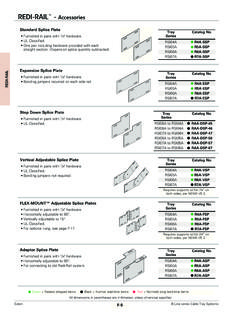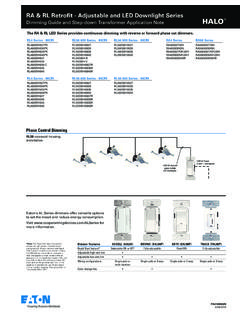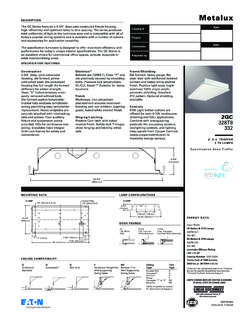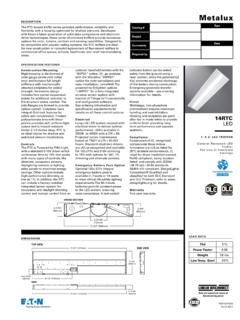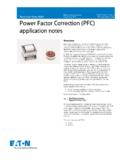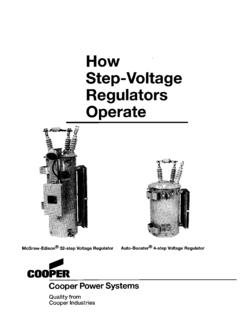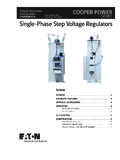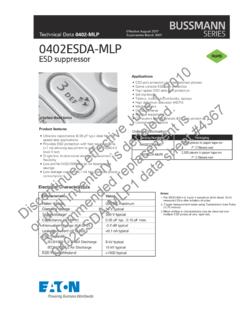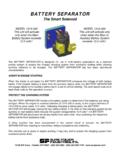Transcription of Engineers guide to structural steel savings with B-Line ...
1 Engineers guide to structural steel savings with B-Line series cable ladder systemB-LINESERIESS tructural steel savingsSSS-17 Engineers guide to structural steel savings with B-Line series cable ladder system CA302003EN August 2017 of ContentsCable ladder Best Practice ..3-4 Evolution of Project savings ..5 structural steel savings Technical White Paper ..6-7 Vertical Inside / Outside Bend Recommendations Option 1 | Span ..8 Option 2 | Dual Support ..9 Option 3 | Dual Support ..10 Option 4 | Floating ..11 Horizontal Bend Recommendations Option 1 | Span.
2 12 Option 2 | Dual Support ..13 Option 3 | Floating ..14 Horizontal Tee Recommendations Option 1 | Span ..15 Option 2 | Span / Dual Support ..16 Option 3 | Dual Support ..17 Option 4 | Floating ..18 Horizontal Cross Recommendations Option 1 | Span ..19 Option 2 | Span / Dual Support ..20 Option 3 | Dual Support ..21 Option 4 | Floating ..22 Reducer Fitting Recommendations ..23 Vertical Adjustable Splice Plate Recommendations ..24 Heavy Duty Expansion Splice Plate Recommendations ..25 Case Study ..26 Additional Resources.
3 27 Engineers guide to structural steel savings with B-Line series cable ladder system CA302003EN August 2017 total install cost solution through reduction of structural steel supportsEaton provides solutions that de-risk by design and drive value to our end customers. With Eaton s B-Line series cable ladder , Eaton provides support recommendations that meet and exceed NEMA VE-2 requirements. These methods have been applied across the globe on multiple applications and projects, and have saved customers millions of dollars on structural steel .
4 This brochure provides an overview of Eaton s recommendations for structural steel supports when utilizing Eaton s B-Line series cable ladder , fittings and splice plates. For additional information, and online resources and tools, visit ladder best practiceTo maximize cost savings on any cable ladder project, it is essential that: Electrical and structural Engineers and contractors communicate effectively Support plans and layouts are discussed early on within the project life cycle (FEED - Front End Engineering Design) to ensure proper support placement, minimize construction complexity, and reduce budget spendSupport location best practice 1/4 Span - The method of placing supports at 1/4 span away from a splice plate location on continuous runs.
5 Recommended installation method by NEMA VE 2 and Eaton s B-Line series Up to 50% deflection reduction over simple beam or mid span installations Eliminates hold down clamp and splice hardware interference issues during thermal expansion and contraction See Fig. 1A and Fig. 1B for visual stress comparisonMid-Span - The method of placing supports at 1/2 span away from a splice plate location on continuous runs. Excessive system deflection and stress experienced compared to 1/4 span support methodology Requires additional supports to account for proper thermal expansion and contraction Splice plate performance becomes more influential on deflection See Fig.
6 2A and Fig. 2B for visual stress comparisonSimple Beam (Over Support) - The method of placing supports directly under the splice plate locations on continuous runs. Maximum system deflection and stress experienced Leads to possible installation issues not allowing for proper thermal expansion and contraction See Fig. 3A and Fig. 3B for visual stress comparisonSimple Beam (Over Support)Fig. 3 BMid-SpanFig. 2 BFig. 2 AFig. 3A SpanFig. 1 BFig. 1 ASupport LocationSystem Stress and Deflection-Minimum-Maximum SpanMid-SpanOver SupportFor best performanceSimple Beam (Over Support)Fig.
7 3 BMid-SpanFig. 2 BFig. 2 AFig. 3A SpanFig. 1 BFig. 1 ASimple Beam (Over Support)Fig. 3 BMid-SpanFig. 2 BFig. 2 AFig. 3A SpanFig. 1 BFig. 1 AEngineers guide to structural steel savings with B-Line series cable ladder system CA302003EN August 2017 vs IEC StandardsNational Electrical Manufacturer Association vs. International Electrotechnical & IEC both provide technical requirements regarding the construction, testing, and performance of metallic cable tray systems. However, testing methods differ drastically, showing different performance results.
8 Choosing a manufacturer with proven success with both standards, such as Eaton s B-Line Division, is crucial to help ensure proper system design. IEC has 5 continuous span testing methods where NEMA has only 1 simple beam test method IEC test methods are deflection based while NEMA tests to destruction Splice plates are included within IEC test methods and not for NEMA IEC does not detail support recommendations, the IEC standard refers back to NEMA VE 2 IEC requires 3rd party witness verification (such as DNV) while NEMA is internal.
9 However 3rd party verification for NEMA (such as CSA or DNV) is common practice among top cable tray manufacturers. IEC requires product impact testing with extreme temperaturesUnderstanding Electrical ContinuityThe National Electric Code (NEC) Article 392 states that a cable tray system can be utilized as an EGC (equipment grounding conductor) per the limitations of table (A). Only mechanically discontinuous locations ( expansion splice plates & gaps) need bonding jumpers (required on both side rails) Indoor cable tray runs (when temperature controlled) do not require expansion joints, and therefore, bonding jumpers are not required to maintain electrical continuity Please see Fig.
10 (4): cable ladder Amperage cable tray and ladder systems are tested per UL, CSA, and/or IEC standardsUnderstanding Thermal Expansion Understanding where and how often to allow for thermal expansion and contraction is an essential measure to the longevity of a cable tray system Reduced system performance or failure is often due to improper system design NOT allowing for adequate thermal expansion and contraction o See Fig. (5): Max Spacing Between Expansion Locations o See Fig. (6): Thermal Gap Settingso See Fig.
